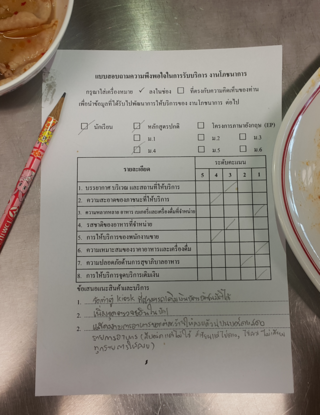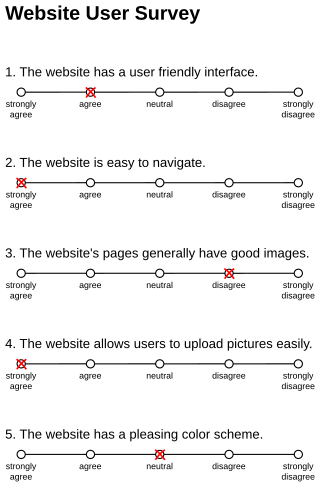Related Research Articles
Marketing research is the systematic gathering, recording, and analysis of qualitative and quantitative data about issues relating to marketing products and services. The goal is to identify and assess how changing elements of the marketing mix impacts customer behavior.
Concept testing is the process of using surveys to evaluate consumer acceptance of a new product idea prior to the introduction of a product to the market. It is important not to confuse concept testing with advertising testing, brand testing and packaging testing, as is sometimes done. Concept testing focuses on the basic product idea, without the embellishments and puffery inherent in advertising.
Stress management consists of a wide spectrum of techniques and psychotherapies aimed at controlling a person's level of stress, especially chronic stress, usually for the purpose of improving everyday functioning. Stress produces numerous physical and mental symptoms which vary according to each individual's situational factors. These can include a decline in physical health, such as headaches, chest pain, fatigue, and sleep problems, as well as depression. The process of stress management is named as one of the keys to a happy and successful life in modern society. Life often delivers numerous demands that can be difficult to handle, but stress management provides a number of ways to manage anxiety and maintain overall well-being.
Questionnaire construction refers to the design of a questionnaire to gather statistically useful information about a given topic. When properly constructed and responsibly administered, questionnaires can provide valuable data about any given subject.
Survey methodology is "the study of survey methods". As a field of applied statistics concentrating on human-research surveys, survey methodology studies the sampling of individual units from a population and associated techniques of survey data collection, such as questionnaire construction and methods for improving the number and accuracy of responses to surveys. Survey methodology targets instruments or procedures that ask one or more questions that may or may not be answered.
An opinion poll, often simply referred to as a survey or a poll, is a human research survey of public opinion from a particular sample. Opinion polls are usually designed to represent the opinions of a population by conducting a series of questions and then extrapolating generalities in ratio or within confidence intervals. A person who conducts polls is referred to as a pollster.

Job satisfaction, employee satisfaction or work satisfaction is a measure of workers' contentment with their job, whether they like the job or individual aspects or facets of jobs, such as nature of work or supervision. Job satisfaction can be measured in cognitive (evaluative), affective, and behavioral components. Researchers have also noted that job satisfaction measures vary in the extent to which they measure feelings about the job. or cognitions about the job.

A Likert scale is a psychometric scale named after its inventor, American social psychologist Rensis Likert, which is commonly used in research questionnaires. It is the most widely used approach to scaling responses in survey research, such that the term is often used interchangeably with rating scale, although there are other types of rating scales.

A questionnaire is a research instrument that consists of a set of questions for the purpose of gathering information from respondents through survey or statistical study. A research questionnaire is typically a mix of close-ended questions and open-ended questions. Open-ended, long-term questions offer the respondent the ability to elaborate on their thoughts. The Research questionnaire was developed by the Statistical Society of London in 1838.

Response bias is a general term for a wide range of tendencies for participants to respond inaccurately or falsely to questions. These biases are prevalent in research involving participant self-report, such as structured interviews or surveys. Response biases can have a large impact on the validity of questionnaires or surveys.

Research design refers to the overall strategy utilized to answer research questions. A research design typically outlines the theories and models underlying a project; the research question(s) of a project; a strategy for gathering data and information; and a strategy for producing answers from the data. A strong research design yields valid answers to research questions while weak designs yield unreliable, imprecise or irrelevant answers.

Employee engagement is a fundamental concept in the effort to understand and describe, both qualitatively and quantitatively, the nature of the relationship between an organization and its employees. An "engaged employee" is defined as one who is fully absorbed by and enthusiastic about their work and so takes positive action to further the organization's reputation and interests. An engaged employee has a positive attitude towards the organization and its values. In contrast, a disengaged employee may range from someone doing the bare minimum at work, up to an employee who is actively damaging the company's work output and reputation.
Acquiescence bias, also known as agreement bias, is a category of response bias common to survey research in which respondents have a tendency to select a positive response option or indicate a positive connotation disproportionately more frequently. Respondents do so without considering the content of the question or their 'true' preference. Acquiescence is sometimes referred to as "yea-saying" and is the tendency of a respondent to agree with a statement when in doubt. Questions affected by acquiescence bias take the following format: a stimulus in the form of a statement is presented, followed by 'agree/disagree,' 'yes/no' or 'true/false' response options. For example, a respondent might be presented with the statement "gardening makes me feel happy," and would then be expected to select either 'agree' or 'disagree.' Such question formats are favoured by both survey designers and respondents because they are straightforward to produce and respond to. The bias is particularly prevalent in the case of surveys or questionnaires that employ truisms as the stimuli, such as: "It is better to give than to receive" or "Never a lender nor a borrower be". Acquiescence bias can introduce systematic errors that affect the validity of research by confounding attitudes and behaviours with the general tendency to agree, which can result in misguided inference. Research suggests that the proportion of respondents who carry out this behaviour is between 10% and 20%.
Computer-assisted web interviewing (CAWI) is an Internet surveying technique in which the interviewee follows a script provided in a website. The questionnaires are made in a program for creating web interviews. The program allows for the questionnaire to contain pictures, audio and video clips, links to different web pages, etc. The website is able to customize the flow of the questionnaire based on the answers provided, as well as information already known about the participant. It is considered to be a cheaper way of surveying since one doesn't need to use people to hold surveys unlike computer-assisted telephone interviewing. With the increasing use of the Internet, online questionnaires have become a popular way of collecting information. The design of an online questionnaire has a dramatic effect on the quality of data gathered. There are many factors in designing an online questionnaire; guidelines, available question formats, administration, quality and ethic issues should be reviewed. Online questionnaires should be seen as a sub-set of a wider-range of online research methods.
Managerial psychology is a sub-discipline of industrial and organizational psychology that focuses on the effectiveness of individuals and groups in the workplace, using behavioral science.

In research of human subjects, a survey is a list of questions aimed for extracting specific data from a particular group of people. Surveys may be conducted by phone, mail, via the internet, and also in person in public spaces. Surveys are used to gather or gain knowledge in fields such as social research and demography.
The term managerial assessment of proficiency (MAP) describes a methodology for the assessment of managerial competence in human resource and training applications. MAP is designed for evaluation of a manager's proficiency in 12 prescribed competencies, and other criteria. Assessments can be generated for an employee, as well as for a department or the organisation as a whole. Normative values, used for comparative purposes in each assessment, are based upon the performance of over 110,000 managers, across 17 countries, in more than 600 organisations that have used MAP, according to the UK-based company, Development Processes Group plc, that licenses the tool into organisations. The Managerial Assessment of Proficiency - (MAP2), copyright 2012, 2014, HRD Press, Inc. is an assessment tool published by HRD Press, Inc. Amherst, MA USA, and is available throughout the world. "Development Processes Group plc" is the exclusive representative in the United Kingdom.
Employee retention is the ability of an organization to retain its employees and ensure sustainability. Employee retention can be represented by a simple statistic. Employee retention is also the strategies employers use to try to retain the employees in their workforce.
With the application of probability sampling in the 1930s, surveys became a standard tool for empirical research in social sciences, marketing, and official statistics. The methods involved in survey data collection are any of a number of ways in which data can be collected for a statistical survey. These are methods that are used to collect information from a sample of individuals in a systematic way. First there was the change from traditional paper-and-pencil interviewing (PAPI) to computer-assisted interviewing (CAI). Now, face-to-face surveys (CAPI), telephone surveys (CATI), and mail surveys are increasingly replaced by web surveys. In addition, remote interviewers could possibly keep the respondent engaged while reducing cost as compared to in-person interviewers.
Employee motivation, also known as work motivation, is a feature of employees that refers to how motivated they are to work. It has a significant impact on employee productivity and efficiency." While motivation is defined as why individuals do or participate in certain behaviors.
References
- ↑ Knapp, Paul R. and Bahaudin G. Mujtaba. May 2010. "Designing, administering, and utilizing an employee attitude survey." Journal of Behavioral Studies in Business. Volume 2
- 1 2 Viteles, Morris S. Motivation and Morale in Industry. New York: Norton, 1953.
- ↑ Samuel Stouffer et al, Studies in Social Psychology in World War II (Princeton: Princeton University Press 1949), 1:Ch. 1
- ↑ "Veridic Technologies Pvt Ltd Employee Survey Report". scribd. Veridic Technologies Pvt Ltd. Retrieved 16 December 2016.
- ↑ Burke, R. J., & Cooper, C. L. (Eds.) (2006). The Human Resources Revolution: Why putting people first matters. Bingley, UK: Emerald Group Publishing Limited.
- ↑ "Employee Surveys". opm.gov.
- ↑ Böckerman, Petri and Pekka Ilmakunnas. April 2012. "The Job Satisfaction-Productivity Nexus: A Study Using Matched Survey and Register Data." ILR Review. vol. 65 no. 2. 244-262.
- ↑ A.N. Oppenheim. Questionnaire Design and Attitude Measurement. Basic Books, Inc. New York. 1966. "Question-Wording."
- ↑ Cantril, H (ed.) Gauging Public Opinion. Princeton University Press. Princeton, NJ.1944. Cited by H.H. Remmers. Introduction to Opinion and Attitude Measurement. Greenwood Press. Westport, CT. 1972.